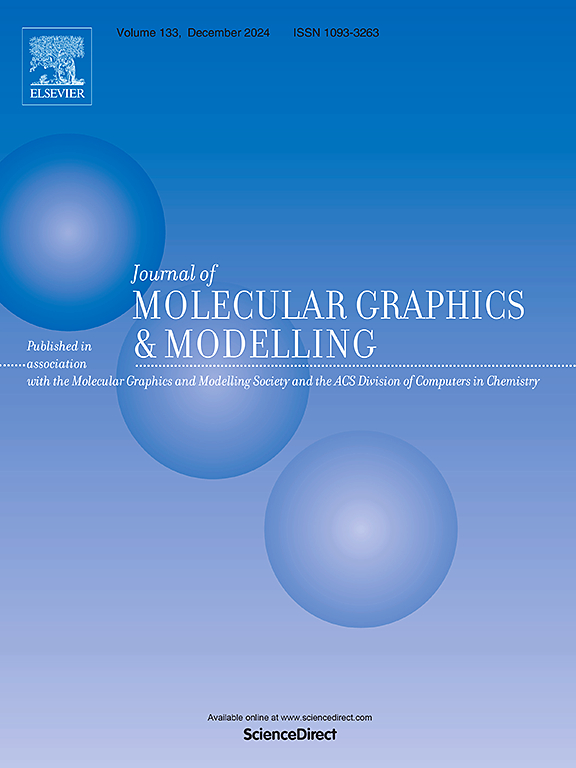非共价主客相互作用释放mof在麻醉氙气恢复方面的潜力:GCMC和DFT对真实麻醉条件的见解
IF 3
4区 生物学
Q2 BIOCHEMICAL RESEARCH METHODS
引用次数: 0
摘要
创新设计提供经济高效的氙(Xe)回收方法,对于开发可持续应用变得越来越重要。最近,使用金属有机框架(mof)作为从麻醉气体混合物中分离Xe的候选材料显示出了希望,然而,可用的研究有限。我们采用大正则蒙特卡罗(GCMC)和密度泛函理论(DFT)相结合的模拟方法来确定19个mof从呼出的麻醉气体混合物Xe/CO2/O2/N2中恢复Xe的能力。COCMUE, GUHMIH, MAHCOQ和PADKOK已经证明了总体上更大的体积和重量的Xe吸收率,证明了配体类型如何增强mof中Xe的选择性吸附。在低压下,Xe原子主要吸附在配体附近,MOF结构中的四唑、苯基、吡啶基、羧酰胺、二羧酸、苯恶嗪和三唑配体是Xe的捕获位置。电子结构分析表明,xe -宿主相互作用主要由电荷诱导的偶极子相互作用和氧原-π相互作用驱动。我们的GCMC和DFT联合研究表明,使用具有适当化学和几何特性的MOFs可以从真实的麻醉呼出气体混合物中捕获相对大量的麻醉Xe。这些特性最大限度地提高了Xe与宿主的非共价相互作用,最终使Xe能够作为麻醉气体在临床应用中得到利用。本文章由计算机程序翻译,如有差异,请以英文原文为准。

Noncovalent guest-host interactions unlock the potential of MOFs for anesthetic xenon recovery: GCMC and DFT insights into real anesthetic conditions
Innovative designs offering cost-effective and highly efficient methods for xenon (Xe) recovery are becoming important for developing sustainable applications. Recently, the use of metal–organic frameworks (MOFs) has shown promise as candidates for separating Xe from anesthetic gas mixtures, however, there are limited studies available. We conducted combined Grand Canonical Monte Carlo (GCMC) and Density Functional Theory (DFT) simulations to determine the Xe recovery capacities of 19 MOFs from the exhaled anesthetic gas mixture, Xe/CO/O/N. COCMUE, GUHMIH, MAHCOQ, and PADKOK have demonstrated overall larger volumetric and gravimetric Xe uptake, demonstrating how ligand types can enhance selective Xe adsorption in MOFs. At low pressures, Xe atoms mainly adsorbed in close vicinity to the ligands, with tetrazole, phenyl, pyridyl, carboxamide, dicarboxylic acid, phenoxazine, and triazole ligands in the MOF structures acting as Xe trapping locations. Electronic structure analyses reveal that Xe-host interactions are primarily driven by charge-induced dipole and aerogen– interactions. Our combined GCMC and DFT study shows that a relatively high amount of anesthetic Xe can be captured from real anesthetic exhale gas mixtures using MOFs with the proper chemical and geometrical characteristics. These characteristics maximize noncovalent Xe-host interactions and ultimately enable the utilization of Xe as an anesthetic gas in clinical applications.
求助全文
通过发布文献求助,成功后即可免费获取论文全文。
去求助
来源期刊

Journal of molecular graphics & modelling
生物-计算机:跨学科应用
CiteScore
5.50
自引率
6.90%
发文量
216
审稿时长
35 days
期刊介绍:
The Journal of Molecular Graphics and Modelling is devoted to the publication of papers on the uses of computers in theoretical investigations of molecular structure, function, interaction, and design. The scope of the journal includes all aspects of molecular modeling and computational chemistry, including, for instance, the study of molecular shape and properties, molecular simulations, protein and polymer engineering, drug design, materials design, structure-activity and structure-property relationships, database mining, and compound library design.
As a primary research journal, JMGM seeks to bring new knowledge to the attention of our readers. As such, submissions to the journal need to not only report results, but must draw conclusions and explore implications of the work presented. Authors are strongly encouraged to bear this in mind when preparing manuscripts. Routine applications of standard modelling approaches, providing only very limited new scientific insight, will not meet our criteria for publication. Reproducibility of reported calculations is an important issue. Wherever possible, we urge authors to enhance their papers with Supplementary Data, for example, in QSAR studies machine-readable versions of molecular datasets or in the development of new force-field parameters versions of the topology and force field parameter files. Routine applications of existing methods that do not lead to genuinely new insight will not be considered.
 求助内容:
求助内容: 应助结果提醒方式:
应助结果提醒方式:


